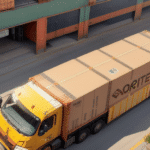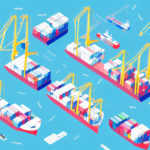How to Obtain an Export License for Your Supply Chain
Are you planning to export goods to foreign countries? Understanding the regulations governing exports is vital. One of the most critical regulations is obtaining an export license. This article guides you through the steps involved in obtaining an export license, including the types of licenses available, the application process, and the necessary precautions to maintain compliance with export control regulations.
Understanding Export Control Regulations
Before obtaining an export license, it's essential to understand the governing regulations. These regulations are overseen by several government bodies, including the Bureau of Industry and Security (BIS), the Department of State, and the Department of the Treasury.
The primary aim of these regulations is to ensure that exported goods do not end up in the hands of individuals or entities that pose a threat to national security or engage in terrorist activities. Additionally, these regulations support national goals such as protecting human rights and maintaining international peace and stability.
Export control regulations cover not only physical goods but also software, technology, and technical data. They apply to all types of exports, including temporary exports, re-exports, and deemed exports. Understanding the specific regulations that apply to your product or service is crucial before exporting.
Violating export control regulations can result in severe consequences, including hefty fines, imprisonment, and loss of export privileges. Compliance is essential to avoid legal and financial penalties and to protect national security interests.
Types of Export Licenses You Need to Know About
Within the U.S., there are two main types of export licenses:
- General License: Allows the export of goods to specific destinations without individual approval. These licenses are typically granted if the export poses no significant national security risks.
- Individual License: Required for exports that pose significant risks to national security or are subject to strict export control regulations. Each export transaction requires a separate individual license.
Export licenses are not only required for physical goods but also for certain types of technology and software. These items may be subject to export control regulations if they contain sensitive information or have potential military applications. Consulting with an export control specialist can help determine if your product requires an export license.
Steps Involved in Applying for an Export License
The process of acquiring an export license involves several steps:
- Determine the Classification of Your Product: Every product must have a classification number to determine if it requires an export license. Use the Classification Tool on the Bureau of Industry and Security (BIS) website to identify your product's classification number.
- Identify the Licensing Agency: Once you establish your product's classification, identify the licensing agency responsible for issuing the license. The BIS typically handles licensing for products under its jurisdiction.
- Fill Out and Submit the Application: Complete and submit the appropriate application form to the licensing agency. Provide detailed information about your business, the product, and the destination country.
- Wait for Approval: After submission, wait for the licensing agency to approve your application. Approval times can vary based on the complexity of the application.
Some products may require additional documentation or permits for export. For example, items considered sensitive or with national security implications may need further clearance from other government agencies. Research and understand all requirements related to your product before starting the export license application process.
Factors to Consider Before Applying for an Export License
Before applying for an export license, consider the following factors:
- Nature of the Product: Determine whether your product requires an export license.
- Destination Country: Different countries have varying import regulations, and some may require additional certifications for specific goods.
- End-User: Ensure the end-user is legally permitted to own or use the product.
- Licensing Agency: Identify the appropriate agency responsible for issuing the license.
Additionally, assess the political and economic stability of the destination country and any potential security risks during transportation. Ensuring compliance with all relevant export regulations and laws is essential to avoid severe penalties, including fines and imprisonment.
Common Pitfalls to Avoid When Applying for an Export License
Companies often make several common mistakes when applying for an export license:
- Incomplete Applications: Submitting incomplete or incorrect applications can lead to delays or rejection.
- Ignoring Red Flags: Overlooking suspicious end-users, destinations, or parties in a transaction may result in penalties and legal action.
- Relying on General Licenses: Applying for individual licenses when necessary is crucial, as reliance on general licenses may result in non-compliance.
Stay updated with any changes in regulations and laws related to export licenses to avoid non-compliance and legal consequences. Additionally, ensure that all employees involved in the export process receive proper training on regulations and requirements for obtaining an export license.
Tips for Ensuring Smooth Processing of Your Export License Application
Implement the following tips to ensure your export license application is processed smoothly and efficiently:
- Ensure Accuracy: Complete your application form accurately with updated information.
- Check Export Control Lists: Before exporting, verify relevant names, countries, and entities against the Consolidated Screening List to ensure compliance.
- Communicate with the Licensing Agency: Maintain regular communication with the licensing agency to ensure all necessary documents are submitted and requirements are met.
Remember that processing times for export license applications can vary based on the product type and destination country. Submit your application well in advance of your intended export date to accommodate potential delays.
How to Track Your Export License Application Status
After submitting your export license application, you can track its status using the following methods:
- BIS System: Utilize the BIS online system to receive email updates on your application's status, including approval or rejection decisions.
- Contact Licensing Officer: Reach out directly to the licensing officer handling your application for status inquiries.
Processing times can vary based on application complexity and volume. If you haven't received updates within a reasonable timeframe, contact the BIS help desk for assistance.
What to Do If Your Export License Application Is Rejected
If your export license application is rejected, take the following steps:
- Understand the Reasons: Contact the relevant licensing agency to understand why your application was rejected.
- Address Concerns: Rectify any errors or address concerns highlighted by the agency.
- Resubmit Application: Follow the agency's specific instructions to resubmit your application for reconsideration.
If the rejection is due to a violation of export control regulations, seek legal advice to understand your options and potential consequences. Ignoring violations can result in severe penalties, including fines and imprisonment.
Best Practices for Maintaining Compliance with Export Control Regulations
To ensure ongoing compliance with export control regulations, consider implementing the following best practices:
- Designate an Export Compliance Officer: Appointing a dedicated officer to oversee export activities can help mitigate potential risks.
- Conduct Regular Assessments: Regularly assess your compliance processes and implement corrective measures as needed.
- Provide Training: Ensure that relevant employees receive training on regulatory requirements and compliance implications.
Additionally, establish a comprehensive compliance program that includes policies and procedures for identifying and managing export control risks. Conduct regular audits and reviews to ensure adherence to all relevant regulations.
Maintain accurate and up-to-date records of all export activities, including shipments, transactions, and communications. Detailed records enable quick identification of potential compliance issues and facilitate corrective actions.
Expert Advice on Navigating the Export Licensing Process
If you need additional assistance with the export licensing process, consult a professional export lawyer. Expert legal advice can help you understand regulatory requirements and mitigate potential risks associated with exporting.
Top Resources and Tools for Obtaining an Export License
Utilize the following resources and tools to aid in obtaining an export license:
- Bureau of Industry and Security (BIS): The BIS provides online tools for classifying goods, identifying licensing agencies, and submitting applications. Visit their website at www.bis.doc.gov.
- Export.gov: This platform offers valuable information on regulatory requirements and export compliance resources to support companies in obtaining an export license. Access it at www.export.gov.
Case Studies: Successful Examples of Companies Obtaining and Maintaining an Export License
Several companies have successfully navigated the export licensing process and maintained compliance with regulatory requirements. Notable examples include:
- IBM: IBM has implemented a comprehensive compliance program, including regular risk assessments and appointing a chief compliance officer, which has facilitated successful navigation of the export licensing process.
- Northrop Grumman: Northrop Grumman invests in robust compliance training and internal processes for identifying and addressing compliance risks, resulting in successful acquisition and maintenance of their export licenses.
Obtaining an export license is a complex process that requires attention to detail and compliance with numerous regulatory requirements. By following the steps outlined in this article, consulting with experienced professionals, and implementing best practices, companies can navigate the process effectively and maintain a competitive edge in the global market.






















